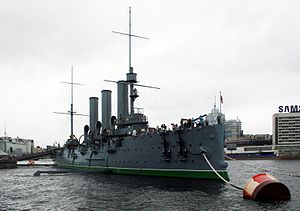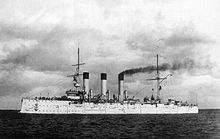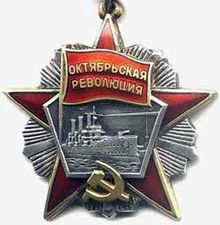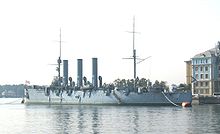- Russian cruiser Aurora
-

Aurora, moored in St. PetersburgCareer (Russia) 
Operator:  Russian Navy
Russian Navy
 Soviet Navy
Soviet NavyBuilder: Admiralty Shipyard, St. Petersburg Laid down: 23 May 1897 Launched: 11 May 1900[1] Commissioned: 29 July 1903 In service: 1903-1957 Honours and
awards:Participated in:
- Dogger Bank incident (1904)
- Battle of Tsushima (1905)
- October Revolution (1917)
Status: Active, preserved at St. Petersburg, Russia General characteristics Class and type: Pallada-class protected cruiser Displacement: 6731 tons Length: 126.8 m (416 ft) Beam: 16.8 m (55 ft) Draught: 7.3 m (24 ft) Propulsion: 1903:
Triple shaft. Three triple expansion reciprocating steam engines; 24 coal-fired Belleville boilers. Total power 11,610 hp[2]Speed: 19 knots Range: 7,200 km (4,500 mi) at 10 knots Complement: 590[1] Armament: 1903:
1917:
8 x 152 mm (6 inch) guns
24 x 75 mm guns
8 x 37 mm guns
3 x torpedo tubes (two underwater)
14 x 152 mm guns
4 x 76 mm AA guns
Machine guns
3 x torpedo tubes (two underwater)Aurora (Russian: Авро́ра; English transliteration: Avrora) is a 1900 Russian protected cruiser, currently preserved as a museum ship in St. Petersburg. She battled the Japanese Navy in the Russo-Japanese War. One of the first incidents of the October Revolution in Russia took place on the cruiser Aurora.
Contents
Russo-Japanese War
Aurora was one of three Pallada-class cruisers, built in St. Petersburg for service in the Pacific Far East. All three ships of this class served during the Russo-Japanese War. The second ship, Pallada, was sunk by the Japanese at Port Arthur in 1904. The third ship, Diana, was interned in Saigon after the Battle of the Yellow Sea.
Aurora was part of the Russian 2nd Pacific Squadron formed mostly from the Russian Baltic Fleet, which was sent from the Baltic Sea to the Pacific, under the command of Vice-Admiral Zinovy Rozhestvensky. On the way to the Far East, she sustained light damage from confused friendly fire in the Dogger Bank incident.
On 27 and 28 May 1905, Aurora took part in the Battle of Tsushima, along with the rest of the Russian squadron. During the battle, the wounded Senior officer of the ship, Captain of 2nd rank Arcadi Konstantinovich Nebolsine took the command of the cruiser. After that Aurora, covering other, much slower Russian vessels, under the command of Rear-Admiral Oskar Enkvist, with two other Russian cruisers broke through to neutral Manila, where she was interned.
In 1906, Aurora returned to the Baltic and became a cadet training ship. From 1906 until 1912 the cruiser visited a number of other countries; in November 1911 the ship was in Bangkok as part of the celebrations in honour of the coronation of the new King of Siam.
The cruiser cooperated also in the international operation to care for the survivors of the earthquake of Messina.
October Revolution
During the First World War the ship operated in the Baltic Sea. In 1915 her armament was changed to fourteen 152 mm (6 in) guns. At the end of 1916, the ship was moved to Petrograd (the renamed St Petersburg) for a major repair. The city was brimming with revolutionary ferment and part of her crew joined the 1917 February Revolution. A revolutionary committee was created on the ship, with Aleksandr Belyshev elected as its captain. Most of the crew joined the Bolsheviks, who were preparing for a Communist revolution.
On 25 October 1917, Aurora refused to carry out an order to put to sea, which sparked the October Revolution. At 9.45 p.m. on that date, a blank shot from her forecastle gun signalled the start of the assault on the Winter Palace, which was to be the last episode of the October Revolution. The cruiser's crew took part in the attack.
Second World War
In 1922, Aurora was brought to service again as a training ship. During the Second World War, the guns were taken from the ship and used in the land defence of Leningrad. The ship herself was docked in Oranienbaum port, and was repeatedly shelled and bombed. On 30 September 1941 she was damaged and sunk in the harbour.
After extensive repairs in 1945 - 1947, Aurora was permanently anchored on the Neva in Leningrad (now St Petersburg) as a monument to the Great October Socialist Revolution and in 1957 became a museum-ship.
On 2 November 1927, Aurora was awarded the Order of the Red Banner for her revolutionary merits and on 22 February 1968 the Order of the October Revolution. The latter features the image of the cruiser herself.
To the present
As a museum ship, the cruiser Aurora became one of the many tourist attractions of Leningrad (now Saint Petersburg), and continued to be a symbol of the Communist Revolution and a prominent attribute of Russian history. In addition to the museum space, a part of the ship continued to house a naval crew whose duties included caring for the ship, providing security and participating in government and military ceremonies. The crew was considered to be on active duty and was subject to military training and laws.
Having long served as a museum ship, from 1984 to 1987 the cruiser was once again placed in her construction yard, the Admiralty Shipyard, for capital restoration. During the overhaul, due to deterioration, the ship's hull below the waterline was replaced with a new welded hull according to the original drawings. The cut off lower hull section was towed into the Gulf of Finland, to the unfinished base at Ruchi, and sunk near the shore. The restoration revealed that some of the ship parts, including the armour plates, were originally made in England, which put in doubt the previously maintained image of the cruiser as a marvel of authentic Russian naval engineering.[citation needed]
Aurora stands today as the oldest commissioned ship of the Russian Navy, still flying the naval ensign under which she was commissioned. She is still manned by an active service crew commanded by a Captain of the 1st Rank.
From 1956 to the present day 28 million people have visited the cruiser Aurora.
See also
- Russian battleship Potemkin, Russian warship involved in the 1905 Revolution
- The American sail frigate USS Constitution, and the British ship of the line HMS Victory, also kept in commission because of their historical importance
Footnotes
- ^ a b "Official Cruiser Aurora website". http://www.aurora.org.ru/eng/index.php?theme=info. Retrieved 2007-08-04.
- ^ "Best scale models website". http://www.bestscalemodels.com/avrora.html. Retrieved 2007-08-04.
External links
- (English) (Russian) Official website
- The History of the Russian Navy - Defeat at Port Arthur
- HNSA Web Page: Cruiser Aurora
- Aurora Cruiser Museum Ship (Saint Petersburg)
Coordinates: 59°57′19″N 30°20′17″E / 59.95528°N 30.33806°E
Monuments of Saint Petersburg Alexander Column • Bronze Horseman • Hero-City Obelisk • Column of Glory • Cruiser Aurora • Peter I near St. Michael's Castle • Church of the Savior on Blood • Alexander Pushkin in Arts Square • Nikolai Gogol in Konushennaya Street • Chesme Column • Kagul Obelisk • Monument to Nicholas I • Mother Motherland • Moscow Triumphal Gate • Narva Triumphal Gate Preceded by: Bogatyr class - Followed by: Askold
List of ships of the Russian Navy Categories:- Museum ships in Russia
- Buildings and structures of the 1917 Russian Revolution
- World War I cruisers of Russia
- World War II cruisers of the Soviet Union
- Ships of the Imperial Russian Navy
- Ships of the Soviet Navy
- Museums in Saint Petersburg
- History of Saint Petersburg
- Naval mutinies
- Victorian era naval ships of Russia
- 1900 ships
Wikimedia Foundation. 2010.




